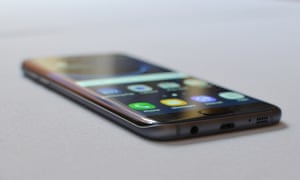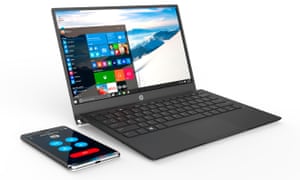From Samsung’s even more curvy Galaxy S7 and S7 Edge to Cat’s thermal camera phone, the best new tech from day one at Barcelona’s Mobile World Congress

The first day of the biggest trade show in smartphones has been and gone with a myriad of shiny new gadgets launched from Samsung, Sony, HP, LG, HTC and even Cat. Here’s what’s hot from Barcelona’s Mobile World Congress.
1. Samsung Galaxy S7 and S7 Edge

Following up on the redesign of its primarily plastic smartphones into popular premium metal and glass slabs, Samsung’s back with the even more curvy 5.1in Galaxy S7 and bigger 5.5in Galaxy S7 Edge.
They both bring back fan favourites of waterproofing and expandable storage with a microSD card slot. But possibly the most significant thing is that they have larger batteries, hopefully ending the eternal hunt for a power supply.
Samsung also launched a 360-degree camera and will start bundling its Gear VR headsets with the S7.
2. LG G5

Not to be outdone by its Korean rival, LG launched arguably one of the bravest flagship Android smartphones to date. Its new G5 has a metal body, 5.3in quad HD screen, fingerprint scanner on the back and runs Android 6.0 Marshmallow.
But unlike everything else the bottom of the phone is removable, exposing an expansion port and the battery. LG hopes consumers will buy into a modular design that allows them to add more battery, accessories and add-ons by slapping them into the bottom of the phone.
LG also had a slender and light virtual-reality headset, a robotic ball with cameras, IR blasters and a laser pointer built in and a 360-degree camera.
3. HP Elite X3

Computer manufacturer HP is having another stab at the smartphone game after failing with the Palm Pre and a few others.
The Elite X3 is being pitched as the do-it-all Windows 10 device. A dual-sim 6in phablet that slots into a dock to turn it into a Windows 10 PC of sorts, allowing users to connect to an external display, keyboard and mouse. Microsoft’s Lumia smartphones will do something similar, but HP also showed off a “Mobile Extender” that connects to the X3 to turn it into a laptop.
The device has its own battery, a full keyboard, a 12.5in display and various ports.
It’s all powered by Windows 10’s Continuum feature, which provides a PC-like experience from a smartphone when connected to a keyboard, mouse and screen.
The idea isn’t new – Motorola tried something very similar with its Atrix smartphones that slotted into a laptop accessory – and while it will be Windows 10 on the laptop or desktop, users will be limited to Windows Store apps. Desktop apps require x86 chips such as those made by Intel, not mobile chips such as the Qualcomm Snapdragon 820 within the X3, no matter how powerful they are.
4. Cat S60 thermal camera phone

Industrial machinery and clothing brand, Cat, has been making rugged Android smartphones for a couple of years, but its latest has a new trick up its sleeve.
The S60 features a built-in Flir thermal camera for checking temperatures, spotting hotspots and even finding people trapped in wreckages, according to the company.
It’s also waterproof to 5m depth, designed to survive falls of up to 1.8m and certified to US military specifications for shock, heat, dust, salt and other conditions that ruin regular smartphones.
5. HTC Vive

HTC and Valve’s long-awaited virtual reality headset, the Vive, finally has a price and release date. The Vive will cost $799 (£564), with pre-orders starting on 29 February, shipping in early April.
In competition with Facebook’s Oculus Rift VR headset, which costs $599, HTC is pitching the Vive as the “complete VR solution” bundling it with two wireless VR controllers, head-tracking sensors and two VR titles. The Vive also has a camera built-in for enabling augmented reality experiences as well as VR, plus is has a phone built into it for making calls, sending messages and checking calendar invites.
It remains to be seen whether consumers, who will also have to either have or shell out for a very powerful computer to run either the Vive or the Oculus Rift, will be swayed by a gaming and computer accessory costing as much as a smartphone.
6. Sony Xperia Ear

Sony’s trying to make Bluetooth headsets cool again (if they ever were). The Xperia Ear is a small earbud that does more than just make calls. It aims to put a digital assistant into your ear, allowing users to get the latest news, weather, social media updates and schedule information.
It responds to voice commands and can perform web searches or give directions, but does not use Android’s built-in Google Now voice assistant, instead relying on Sony’s own systems.
Other manufacturers have tried and failed to make tiny Bluetooth headsets more than just hands-free calling accessories, including Motorola with its Hint. But none have managed to overcome the stigma of wearing such a device in public or convince consumers they want such a thing.
[Source:- The Gurdian]

